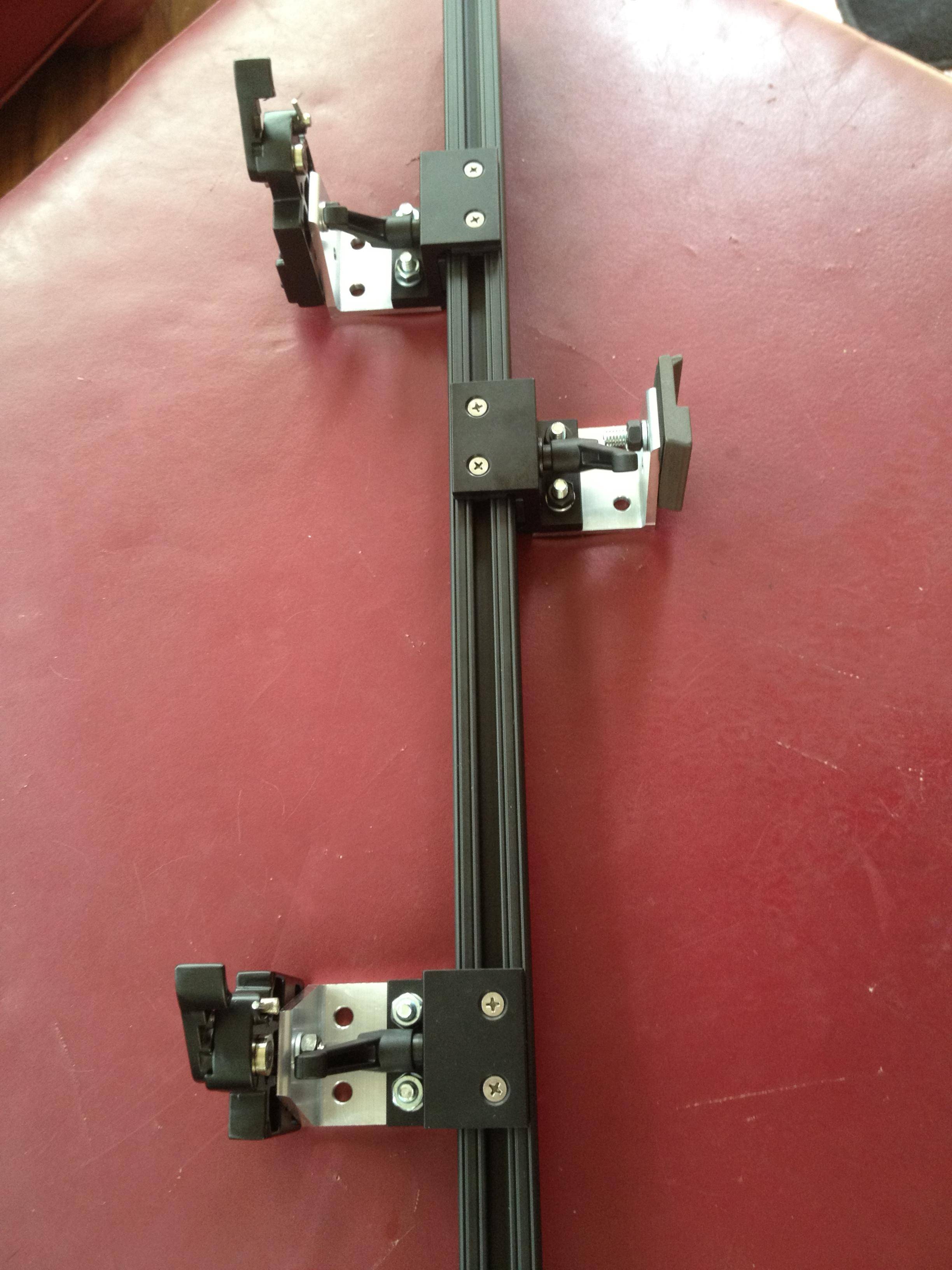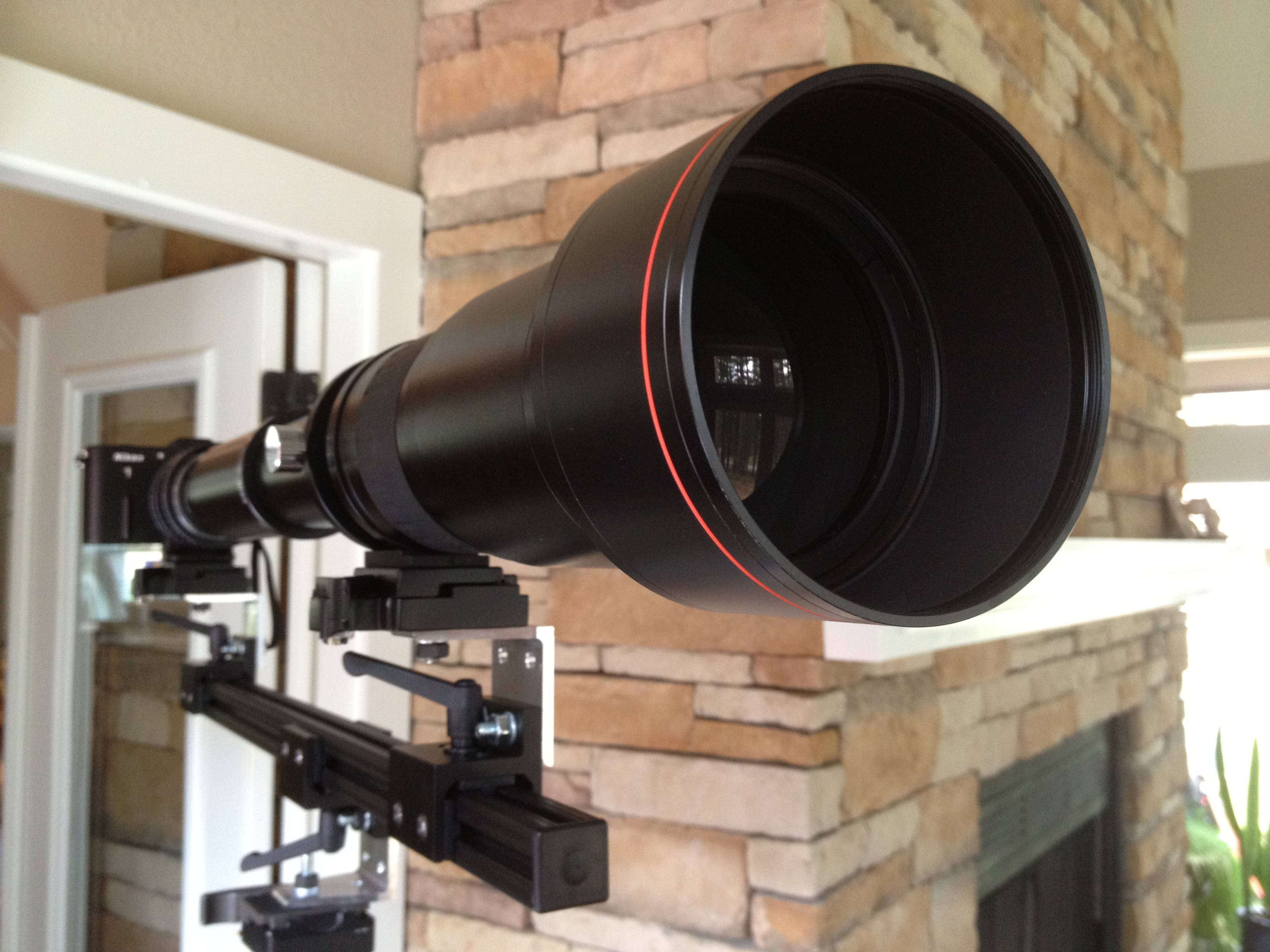What I Would Make
You know what you want. A bar that has a slide mount tripod plate on one side, and two screw mounts on the other, one of which is adjustable height.
Sounds like a chunk of t-slot bar would be ideal. To make the vertical risers two angle brackets and a chunk of the t-slot can be used. This plan will require a drill and a hack saw. When ordering the T-slot bar, aluminum angle brackets, screws, and t-slot screw anchors can be ordered as well.
Parts List
- 3ft by 1 inch t-slot bar
- 4 angle brackets
- 12 t-slot screws, Allen head round nut will look cleanest
- 2 tripod mount size screws (same goes for them).
Make sure that all parts are aluminum or stainless steel (Again, mostly looks, but you never know what bad things happen when rust shows up).

What Could be Bought
Really Right Stuff sells a 'Kennan-Ward-Super-Tele-Package' which looks like it is meant for this situation. IT is $400.
UPDATE: What I Ended Up Doing
I hope it's not against decorum for me to edit your answer so extensively, Phil. I was going to edit my original question but since so much of my solution is derived from your (correct) answer, it seems in spirit to better belong here.
I originally avoided this answer because it would involve "a drill and a hack saw", as I wanted to simply buy something or perhaps assemble parts. But a few days later I was cruising some results while searching for "slotted bars" and found this, a very-cool, DIY camera shoulder mount. It looked sleek, ergonomic, and was using off-the-shelf parts. While reading that it was based on a modular "t-slot bar" system, I wondered how that would compare to the answer above, whereupon I discovered - to my amazement - that Phil had been recommending a "t-slot bar" all along! It was right there under my nose! What was missing for me was an example to make it seem concrete, real, and - most of all - doable.
I spent the next few days perusing the catalogs of various manufacturers and distributors of products for this system. Incredibly, this family of products is a well-defined and rigorously-obeyed standard, and there are hundreds of components to choose from. They are like adult legos (albeit expensive legos), and in fact one company (the one I ended up buying from), 80/20, bills itself as "the industrial erector set".
My design drifted from the raw concept above in 3 key ways:
- I wanted smooth adjustments of the components, not fixed bolts.
- I wanted quick-release mechanisms across the board.
- I dropped the "variable height" requirement until I could get everything in phase 1 set up - I hadn't figured it out yet and I just couldn't keep it all in my head anymore; I was anxious to see it all together. [As it turns out I don't need adjustable height anyway]
The 1.0 version features a single 2-foot t-slot bar (1" in 'diameter'), with 3 "linear brake" pads mounted on it. To these are bolted corner brackets and finally Manfrotto quick release plates. Everything is 1/4-20 thread and either available at any hardware store or via 80/20's ebay discount bin, where I picked up all this stuff for about $150 after shipping.
So, how does it compare? For one, given the length of this system, none of the commercial examples would support it. Given that my final solution is both cheaper (not including my labor) and more robust (in terms of strength and flexibility), this triple-whammy excludes the commercial products completely and without apprehension or reserve.
Here are shots of the dual mount, the camera gear, the entire setup, and finally a test image. If you examine the base image carefully you can see a tiny red square which is the FoV of the second, tele-tele-tele-photo'ed image. I haven't done the math on the AoV yet but I know it's dramatically in excess of the 7020mm projected given the use of the extension tube set, probably again by double (14000mm, anyone?).
I will be posting some photos from the intended use (lunar photography) tomorrow.











UPDATE: Some Example Lunar Shots
I took off the bellows for these shots. In winter - on a colder night with a larger and fuller moon - I could have a better target, but last night was not ideal for the "14000mm" version. These are "just" 7020mm...

















